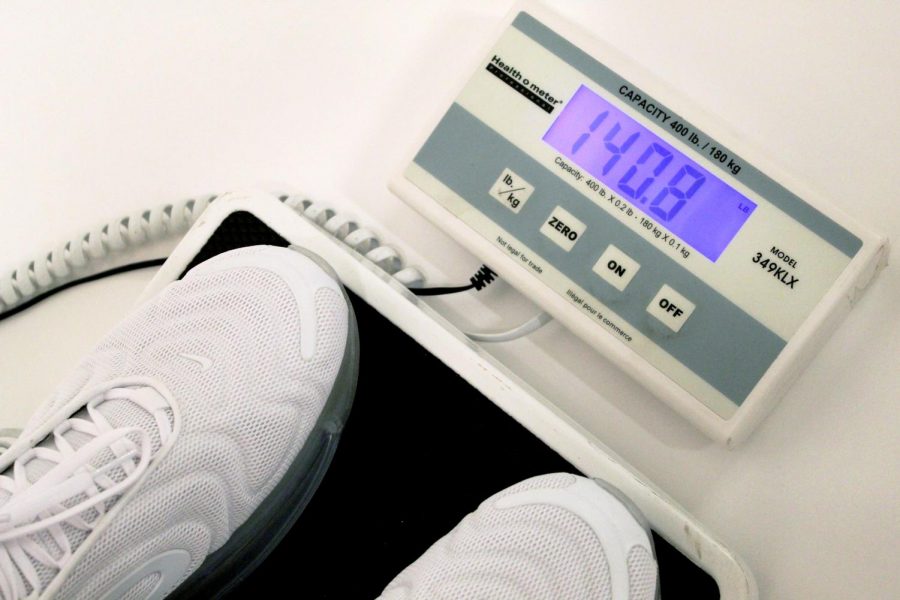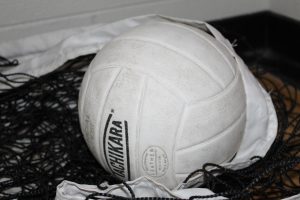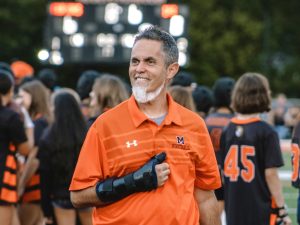Taking one for the team
Athletic injuries are common, but some players make risky choices to put their team above their health
Though the practice of “cutting weight” is illegal according to the IHSA, some wrestlers choose not to eat to keep themselves at the top of their weight class.
December 18, 2019
In an instant, the match is over and a varsity wrestler feels the referee hoist his hand into the air. Beneath him, his defeated opponent tries to catch his breath, but all this wrestler can think of is the food he has waiting for him in his bag. He has spent the past week trying to cut weight to go down a weight class. His head spins as he takes a triumphant bite of his ham sandwich — the first real meal he has eaten in a long time.
Many MCHS athletes have shared that they feel pressure from not only themselves, but also their coaches, teammates, and parents to practice unhealthy behaviors for the sake of their team. They keep injuries quiet, nervous they may lose playing time, or push their injuries on the field or court, causing additional injury.
Coaches dedicate time and work hard to establish trust with their players so that they will communicate with them when they are injured. In order to make sure there are no secrets about major and important issues, students take a yearly online test to establish how the player functions without a concussion. The tests are assigned by the school after tryouts and test on multiple things such as memorization and sensory awareness. If the player has a head injury and does not meet the baseline, they may have a concussion and their doctor can recommend that they are no longer allowed to play. Wrestlers caught cutting weight are also not allowed on the mats. Coaches take such issues seriously, though they persist.
Most students, parents, and coaches know that injuries are common in sports. In fact, according to StopSportsInjuries.org, “Every year an average of 2 million high-school athletes across the U.S. report sports-related injuries.” Head varsity football coach Jon Neimic states, “Football is a contact sport, it’s only natural that you will have weekly injuries. That will come up throughout the season.” Coaches know that it is their responsibility to help players make healthy choices. “We, the coaching staff, work in unison with the athlete and his or her family to ensure the injury is something we can manage with some treatment from our trainer or … by a doctor for further evaluation,” Niemic explains.
StopSportsInjuries.org adds that only 25% of injured high school athletes visit the hospital, and 1.5% are hospitalized due to the severity of their injuries. So why aren’t student athletes taking care of themselves the way they should? Are they pushing themselves too hard, or are they being pushed?
Some athletes believe that coaches do not want them seeing a doctor for some injuries because a doctor is more likely to recommend a player sit out for practices, games, or even the rest of the season. Instead, they visit an athletic trainer who assesses their injury. Frequently, a trainer will simply bandage or put ice on an injury — whatever they feel is enough to send them back to the bench, or even into the game. Many students know this does not fix their injury, but they consider it “fixed enough” to continue playing.
“[Once] I dislocated and fractured my pinky finger during practice,” an athlete, who wishes to remain anonymous, says. “Instead of getting fully evaluated the trainer put it back in place, gave me a splint and sent me back to practice, with my agreement. Then, after practice, I was fully evaluated. At the time I wanted to go back … It maybe wasn’t the best option, but I knew I had to take it to keep my spot.”
Varsity girls’ soccer coach Andrew Stegenga believes that his players know their bodies better than he does, which is why he responds immediately when they need to sit out after an injury. “I will never get mad at a player who is too injured to play,” he says, “But I also know that sometimes high school athletes may need a push of confidence, and will use an injury as an excuse if things are not going well.” In the end, he ultimately leaves the decision up to the players. Even though coaches do try and get the best effort from their athletes, some athletes feel like their coaches push them too hard—and, in some cases, feel unable to communicate their needs to their coach.
Another athlete, who also preferred to remain anonymous, stated, “I’ve had to play and practice when I haven’t felt well, and when I got injured. I’ve also had teammates tell me that they didn’t feel good, but still had to practice in fear of getting in trouble from the coach.”
Students feel the need to please their coaches in any case, but much of the pressure actually comes from themselves. In wrestling, players must maintain a certain weight so they are in the correct class, and wrestle against equal competitors. Sophomore Nolan Carlson explains that his decisions are his alone to make. “I wouldn’t say cutting [weight is the problem],” Carlson says. “I would say it’s more watching it. It’s healthy if you do it the right way, like still eating proteins and veggies. Your coach can tell you whatever, but it’s still up to you. It’s your body, and you can do what you want with it.”
A majority of the pressure student athletes face comes from not wanting to be kicked off their team or miss a game, which may cause players to keep pushing themselves past their limits. However, this does not mean it is purely at the fault of the coaches. Parents can push their students too hard too, and teammates may pressure an athlete to “walk it off” when they should take a seat.
It would be easy and convenient to blame outside sources for the pressure student athletes feel, but in the end, it is mostly internal. Injuries are common with athletes, so it is important for these students to be open and honest with their coaches to avoid risking further and longer-lasting injuries in the future. Though this may result in less playing time, it’ll only benefit them in the long run.
Additional reporting for this story by Stacy Correra and Madison Wise













